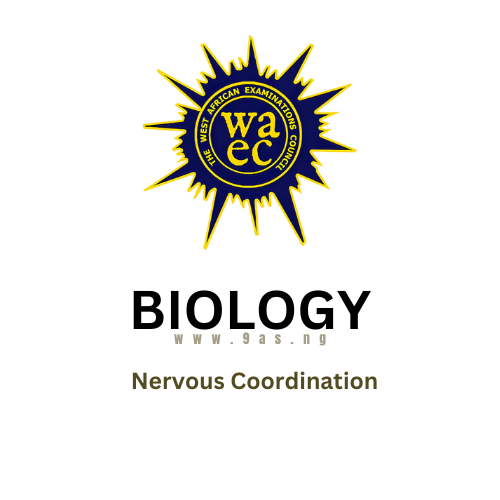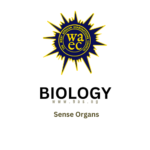OBJECTIVES
1. The legs of an accident victim with a fractured vertebral column and injured spinal cord could not be raised because
A. impulses from receptors in the legs cannot travel to the brain.
B. impulses from the brain cannot travel to the legs.
C. chemical substances will be released at synapses in the central nervous system.
D. reflex actions cannot take place in the legs.
The diagram below is an illustration of the left side of the human cerebrum Anterior

2. The part labelled X controls
A. general memory.
B. speech.
C. sight.
D. respiratory functions.
3. The passage of nerve impulse across a synapse is facilitated by the secretion of
A. acetylcholine.
B. thyroxine.
C. insulin.
D. progesterone.
4. The part of the brain which controls and coordinates body posture is the
A. cerebellum.
B. hypothalamus.
C. medulla oblongata.
D. pons varolii.
5. Which of the following processes is not an example of a reflex action?
A. Blinking of the eye.
B. Reading.
C. Beating of the heart.
D. Sneezing.
6. The part of the ear which contains nerve cells sensitive to sound vibrations is the
A. cochlea.
B. ampulla.
C. tympanum.
D. malleus.
7. Which of the following groups of animals do not possess a nervous system
A. Porifera.
B. Cnidaria.
C. Platyhelminthes.
D. Nematoda.
8. A neurone that transmits impulses directly from sensory cells is called
A. an afferent neurone.
B. an efferent neurone.
C. a relay neurone.
D. a peripheral neurone.
9. The following are all examples of a simple reflex action, except
A. swallowing.
B. sneezing.
C. walking.
D. blinking.
10. Impulses are conducted towards the nerve cell through the
A. myelin sheath.
B. dendrons.
C. axons
D. synaptic nodes
11. Filaments of Spirogyra placed in a beaker of tap water in a dark cupboard died because
A. the filaments could not photosynthesize.
B. conjugation could not take place.
C. the temperature was too high.
D. the plant was over flooded.
12. Which of the following actions is not a voluntary action?
A. Stealing.
B. Sneezing.
C. Fighting.
D. cheating.
13. Which of the following statements about nerve cells is not correct?
A. The axons relay impulses from the cell body.
B. The cell body is always found at the end of the neurone.
C. Each neurone has a cell body.
D. The dendrites of one neurone transmit impulses to the cell body.
14. The smallest branches on the cell body of a neurone are called
A. dendrites.
B. dendrons.
C. ganglia.
D. Schwan cells.
15. Which of the following neurons may not have myelin sheath?
A. Effector cells.
B. Intermediate neurons.
C. Motor neurons.
D. Sensory neurons.
16. Which of the following sequences is the correct route of the transmission of impulses along a reflex are
A. Receptor sensory neurone synapse intermediate neurone synapse motor neurone effector
B. Receptor motor neurone→ synapse intermediate neurone synapse sensory neurone effector.
C. Effector intermediate neurone synapse→ motor neurone→ synapse→ sensory neurone receptor.
D. Effector→ motor neurone→ synapse→ sensory neurone synapse intermediate neurone receptor.
17. Which of the following statements about the response of neurones to stimulus is correct
A. Neurones respond to stimulus of any strength.
B. Neurones respond to all stimuli applied in rapid succession.
C. Neurones respond more rapidly during the absolute refractory period.
D. Intensity of stimulus must reach a threshold value before the neurones can be excited.
18. When an axon is at rest, the concentration of ions on either side of the membrane are different. Which of the following is correct about the concentrations of ions on either side of the membrane?
A. There is an excess of potassium ions inside the axon and an excess of sodium ions outside.
B. The inside of the axon becomes positively charged while the outside is negatively charged.
C. There is an excess of sodium ions on the inner side of the axon.
D. Chloride and potassium ions begin to move across the membrane.
19. The brain and spinal cord make up the
A. peripheral nervous system.
B. autonomic nervous system.
C. central nervous system.
D. somatic nervous system.
20. If the cerebellum of a person is slightly damaged, which of the following will be impaired? A. Vision.
B. Walking.
C. Breathing.
D. Digestion.
21. The nerves that arise from the brain are known as
A. spinal nerves.
B. sacral nerves.
C. cranial nerves.
D. optic nerves.
22. The neurone that relay the message of effector organs are called
A. efferent neurone.
B. intermediate neurones.
C. afferent neurones.
D. spinal nerves.
23. Each neurone consists of the following structures except
A. cell body.
B. dendrite.
C. axon.
D. white of matter.
24. The simplest form of nervous pathway which links receptors with effectors is known as the A. relay neuron.
B. reflex arc.
C. motor nerves.
D. sensoryoxs anamerves.
25. Co-ordination is achieved in the body of mammals through the action of the
A. endocrine and nervous systems.
B. skeletal and nervous systems.
C. muscular and nervous systems.
D. circulatory and nervous systems.
26. The brain and the spinal cord make up the
A. peripheral nervous system.
B. automatic nervous system.
C. central nervous system.
D. somatic nervous system.
27. The part of the brain responsible for the control of voluntary movement and interpretation of sensations is the
A. cerebrum.
B. cerebellum.
C. optic lobe
D. medulla oblongata.
28. Reading the verdict of a case by a judge or magistrate is an example of
A. a reflex action.
B. an instinct.
C. a conditioned reflex.
D. a voluntary action.
29. Which of the following specialized structures are stimulated by touch, pressure, pain, heat and cold?
A. Receptors.
B. Synapse.
C. Cell bodies.
D. Relay neurones.
30. Which of the following is an example of a reflex action?
A. Sneezing.
B, Biting.
C. Dancing.
D. Singing.
Use the diagram below to answer questions 31-33.

31. The part labelled 1 is the
A. white matter.
B. grey matter.
C. central canal.
D. synapse.
32. What is the function of the part labelled IH?
A. Conducting nerve impulses to the receptor organ.
B. Conducting nerve impulses to the effector organ.
C. Translating the impulses into messages.
D. Transmitting the impulses to the brain.
33. Which of the following statements is correct of the
structure labelled III? It
A. consists mainly of cell bodies.
B. conducts impulses to the spinal cord.
C. conducts impulses from the spinal cord to the effect or organs.
D. conducts impulses to the brain.
34. What part of the brain is concerned with the regulation of the heart beat, body temperature and breathing rate?
A. Cerebellum.
B. Medulla.
C. Cerebrum.
D. Olfactory lobe.
35. Which of the following actions is not an example of a simple reflex action?
A. Knee jerk.
B. Blinking of the eye.
C. Withdrawal of hand from hot object.
D. Reading a book.
36. The central nervous system in humans is made up of the
A. brain, medulla oblongata and nerves.
B. brain, spinal cord and cranial nerves.
C. brain and spinal nerves.
D. brain and spinal cord.
Use the diagram below to answer questions 37 and 38

37. The cell body in the diagram is labelled
A. I.
B. II.
C. III.
D. IV.
38. The function of the part labelled II in the diagram is to
A. transmit impulse from one end of the cell to the other.
B. manufacture food for the cell,
C. protect the axon.
D. produce energy for the cell.
39. The part of the nervous system that interprets blinking of the eye is the
A. spinal cord.
B. cerebrum.
C. hind brain.
D. olfactory lobe.
40. The organic molecule(s) present in the nucleus is/are
A. DNA.
B. Protein, RNA and DNA.
C. RNA and ATP.
D. RNA.
41. Which of the following is the correct route of transmission of impulses along a reflex arc?
A. Receptor-> sensory neurone -> synapse -intermediate neurone – synapse -> motor neurone ->
effector.
B. Receptor -> motor neutron -> synapse ->intermediate neurone -> synapse -> sensory neurone ->effector.
C. Receptor -> synapse -> sensory neurone ->intermediate neurone -> synapse -> effector -> motorneurone.
D. Effector -> motor neurone -> synapse -sensory neurone -> synapse -> intermediate neurone ->receptor.
42. The following are directly involved in transmission of sound waves to the brain except
A. eardrum.
B. auditory meatus.
C. auditory ossicles.
D. Eustachian tube
43. The spaces between neurones through which impulses cross by means of chemical reaction are called
A. axons.
B. ganglia.
C. synapses.
D. dendrites.
44. The autonomic nervous system comprises
A. sympathetic and parasympathetic systems.
B. cranial and sacral nerves.
C. brain and cranial nerves.
D. spinal cord and spinal nerves.
45. The medulla oblongata controls all the following except
A. heart beat.
B. breathing rate.
C. blood pressure.
D. balance and posture.
46. Which of the following parts of the mammalian brain is involved in taking the decision to run rather than walk?
A. Cerebellum.
B. Medulla oblongata.
C. Cranial nerves.
D. Cerebrum.
The diagram below is the dorsal view of a mammalian brain,Use it to answer questions 47 and 48

47. The structure labelled I in the diagram above is the
A. cerebellum.
B. cerebrum.
C. olfactory lobe.
D. medulla oblongata.
48. The structure labelled VIII in the diagram is responsible for
A, vision.
B. involuntary actions.
C. speech.
D. voluntary action.
Study the diagram below and use it to answer questions 49 and 50

49. The part labelled II in the diagram is the
A. central canal.
B. grey matter.
C. spinal cord.
D. dorsal root.
50. Which of the labelled parts is filled with cerebrospinal fluid?
A. V and I.
B. V only.
C. Ill only.
D. I only.
51. Which of the following statements is not true about hormones?
A. Their responses are voluntary
B. They may affect more than one target organ
C. They are chemical messengers in animals
D. They are transported by the blood to the target organs.
52. Deficiency in insulin could lead to
A. cirrhosis.
B. hepatitis.
C. diabetes.
D. nephritis.
The diagram below is an illustration of a human brain.
Study it and answer questions 53 and 54.

53. The part labelled I is the
A. olfactory lobe.
B. cerebellum.
C. cerebrum.
D. medulla oblongata.
54. The function of the part labelled II is that it controls
A. posture and balance of body.
B. all voluntary actions.
C. temperature and appetite.
D. many involuntary actions.
55. The part of the central nervous system that controls unconscious actions in humans is the
A. Cerebellum.
B. Cerebrum.
C. Spinal cord.
D. Optic nerves
THEORY
1. Make a diagram 10 – 12 cm long of the reflex arc and label fully.
(a) Describe the processes that will cause a person who has been spinning to feel dizzy.
(b) State two functions each of the following structures:
(a) Cerebellum
(b) Cerebrum
(c) Medulla Oblongata.
2. Describe briefly the mechanism of transmission of impulses through a nerve fibre.
Explain the following terms
(i) voluntary action
(ii) involuntary action.
3. Describe the mechanism of transmission of impulses through a nerve fibres.
(a) Name three main parts of the human brain
(b) State the functions of the following:
(i) Cerebrum
(ii) Hypothalamus
(iii) Medulla Oblongata.



